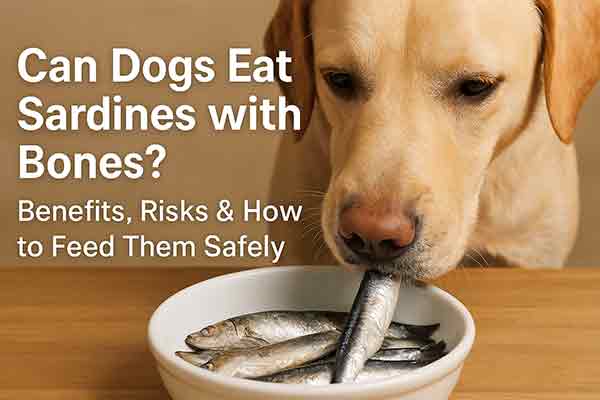Can Dogs Eat Sardines with Bones? Benefits, Risks & How to Feed Them Safely
Table of Contents
- Introduction
- Nutritional Benefits of Sardines for Dogs
- Are Sardine Bones Safe for Dogs?
- Fresh vs. Canned Sardines: Which Is Better?
- How to Safely Serve Sardines with Bones
- Recommended Portion Sizes for Dogs
- Potential Risks of Feeding Sardines with Bones
- Alternatives to Sardines for Omega-3
- Frequently Asked Questions
- Conclusion
Introduction
Fish is a healthy addition to a dog’s diet, and sardines are among the most popular choices. But many pet parents wonder: Can dogs eat sardines with bones? The answer is yes—but there are a few important things to know first. In this comprehensive guide, we’ll break down the nutritional benefits of sardines, the safety of their bones, how to prepare them, and how often they can be fed to your dog.
Nutritional Benefits of Sardines for Dogs
Sardines are packed with essential nutrients that support your dog’s overall health. These include:
- Omega-3 fatty acids: Promote a shiny coat, reduce inflammation, and support heart health.
- Protein: Builds and repairs tissues, supports muscle maintenance.
- Calcium and phosphorus: Support strong bones and teeth.
- Vitamin D: Aids calcium absorption and bone health.
- Vitamin B12: Supports nerve function and energy production.
- Coenzyme Q10 (CoQ10): Aids in cellular energy and heart function.
For dogs with skin issues, allergies, or inflammation, sardines can be a game-changer when introduced properly.
Are Sardine Bones Safe for Dogs?
Unlike the bones in larger fish or meats, sardine bones are soft, small, and usually safe for dogs to eat. When sardines are cooked or canned (especially in water or natural oils), their bones become even softer—making them easy to chew and digest.
Still, it’s important to supervise your dog the first few times they eat sardines with bones, especially if they tend to gulp their food without chewing.
Fresh vs. Canned Sardines: Which Is Better?
Both fresh and canned sardines offer nutritional benefits, but there are a few things to consider:
Fresh Sardines
- Free from preservatives
- Can be cooked gently (steamed or baked)
- Best if sourced from reputable seafood suppliers
Canned Sardines
- Convenient and shelf-stable
- Choose sardines in water or olive oil—avoid those in brine, soy, or sauces
- Check for added salt or seasoning
For dogs, canned sardines in water or olive oil are usually the best and safest option.
How to Safely Serve Sardines with Bones
Here’s how to safely incorporate sardines into your dog’s diet:
- Start small: Introduce sardines gradually to avoid digestive upset.
- Check the label: Ensure there are no added seasonings, onions, garlic, or high sodium.
- Use as a topper: Mix sardines into your dog’s regular food for a nutritional boost.
- Watch for reactions: Monitor for allergies or digestive changes.
- Limit frequency: Sardines are high in fat, so don’t overfeed.
Recommended Portion Sizes for Dogs
While sardines are nutrient-dense, moderation is key. Here’s a general guideline:
- Small dogs (under 20 lbs): 1/4 to 1/2 sardine 1–2 times per week
- Medium dogs (20–50 lbs): 1/2 to 1 sardine 1–2 times per week
- Large dogs (50+ lbs): 1–2 sardines 1–2 times per week
Always consult with your vet if your dog has health conditions such as pancreatitis, allergies, or weight issues.
Potential Risks of Feeding Sardines with Bones
Though sardine bones are generally safe, there are a few risks to be aware of:
- Choking hazard: Rare but possible, especially for small dogs or fast eaters.
- Excess fat: Can contribute to weight gain or pancreatitis if overfed.
- High sodium (in canned varieties): Can be dangerous if not properly sourced.
- Mercury and contaminants: Sardines are low on the food chain, so they’re safer—but still best fed occasionally.
Alternatives to Sardines for Omega-3
If sardines aren’t an option or your dog doesn’t like them, try these alternatives:
- Salmon (boneless and cooked)
- Mackerel (in moderation)
- Anchovies (low sodium, canned in water)
- Omega-3 supplements for dogs (vet-recommended)
- Flaxseed or chia seed (plant-based omega-3)
Frequently Asked Questions
Can dogs eat sardines every day?
No. While nutritious, sardines should be limited to 1–2 times per week to avoid excess fat and maintain dietary balance.
Are raw sardine bones safe?
Raw sardine bones are generally soft and safe, but always supervise and source from trusted suppliers. Cooked bones from larger fish are not safe.
Can puppies eat sardines with bones?
Yes, in small amounts. Introduce slowly and consult your vet first—especially if your puppy is on a specific diet plan.
Conclusion
Can dogs eat sardines with bones? Yes, when prepared properly and served in moderation. Sardines are rich in nutrients that support heart, joint, and skin health, and their soft bones are safe for most dogs to eat. Whether you choose fresh or canned sardines, always prioritize quality and avoid added salt, spices, or preservatives. As with any dietary change, consult your veterinarian before adding sardines to your dog’s meal routine.
Looking for more healthy treats for dogs? Explore our blog for evidence-based nutrition guides and expert wellness tips.







